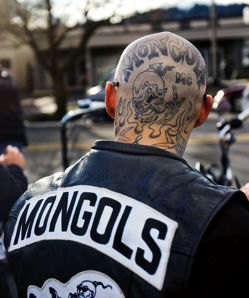When an ordinary Harley-Davidson Sportster arrived at Mike Wilson’s Iowa dealership in 1957, there was no way of knowing it would become a legendary motorcycle.
harley davidson
Friday, October 21, 2011
Drag Strip 101
The dragstrip is 1,320 feet long. You've got your stage beams, and then 60 feet out you've got your 60 foot clock. After your 60 foot clock, you've got your 330 foot clock. Those are just incrementals. After the 330 clock, you get to the 1/8th mile clock.
Now, they set a trap that is a set distance between a mph block and the 660 [foot] block that calculates your speed; you get an eighth mile (660) mph and E/T, it's going to tell you how fast you're going.
Tuesday, October 18, 2011
A Dark Custom American Legend: 2012 Sportster Forty-Eight
 Since 1948, the Sportster models have been making garages blush. In 1948, Harley-Davidson first introduced the authentic peanut tank that is now a key feature on all Sportster models. The peanut shell shows off the engine, giving this model all the attitude to conquer the road ahead. The will have you screaming to break out of your cage.
Since 1948, the Sportster models have been making garages blush. In 1948, Harley-Davidson first introduced the authentic peanut tank that is now a key feature on all Sportster models. The peanut shell shows off the engine, giving this model all the attitude to conquer the road ahead. The will have you screaming to break out of your cage.Think back to those classic motorcycle movies of the 1950’s and this is the bike that will come to mind. The Forty-Eight embodies the essence and style of a simpler time with the performance and handling of a modern machine.
Harley Davidson Engine Modification Manual
 Following Modifikation Manual Engine applies for Harley Davidson motorcycle. There are 4 stages of modification explained and described in this manual. Stage 1 modifications are made by bolt-on changes or modifications to external components on the engine. These components include air cleaners, carburetors, exhaust systems and ignition systems. No special tools or training is required to perform Stage One modifications. These modifications will provide from 55 to 66 horsepower at the rear wheel of a late model 80 CID Harley-Davidson big twin Evolution engine.
Following Modifikation Manual Engine applies for Harley Davidson motorcycle. There are 4 stages of modification explained and described in this manual. Stage 1 modifications are made by bolt-on changes or modifications to external components on the engine. These components include air cleaners, carburetors, exhaust systems and ignition systems. No special tools or training is required to perform Stage One modifications. These modifications will provide from 55 to 66 horsepower at the rear wheel of a late model 80 CID Harley-Davidson big twin Evolution engine. Stage 2 Harley-Davidson engines modification involve Stage 1 changes plus changes to some internal “bolt-in” engine components. These “bolt-in” modifications include camshafts and milling of the heads to increase compression. Some special tools and knowledge of engines is required to perform stage two modifications. These modifications will provide from 60 to 80 horsepower at the rear wheel of a late model 80 CID Harley-Davidson big twin Evolution engine, depending upon the condition of the engine and the components used.
Sunday, October 16, 2011
Motorcycle gangs
 An outlaw biker and his “colors” declare membership in a particular club. Colors usually consist of a three-piece patch embroidered on a leather or denim jacket which contains the name of the club, the club’s logo, and the club’s location.
An outlaw biker and his “colors” declare membership in a particular club. Colors usually consist of a three-piece patch embroidered on a leather or denim jacket which contains the name of the club, the club’s logo, and the club’s location.Bryan Denson of The Oregonian wrote an interesting Article Eko about the rise of Outlaw Motorcycle Gangs OMG in Oregon. Specifically it detailed how the Mongols Motorcycle Club MMC had discretely opened a 4th chapter in Eugene after previously setting up chapters in Portland, Medford and Bend. The article characterized them as one of the most violent OMGs of the “Big Five” and it made me wonder if Oregon was set for a bloody turf war like the late 60′s in San Francisco. The aftermath of many killed bikers was that the Gypsy Jokers MC left California and the Hells Angel agreed to stay out of Oregon.
Saturday, October 15, 2011
1926 Racer Harley Davidson
I bought this bike in full street trim a few months before the Motorcycle Cannonball, but left it parked in secure storage. (I had to focus all my spare time on prepping my 1915 Harley for the cross country ride.) I purchased it from a bar owner who’d shut down his bar and was selling the classic motorcycles he had on display. He’d bought this Harley model J racer a decade or so earlier, and was told it was correct and complete. It wasn’t.
Subscribe to:
Posts (Atom)





